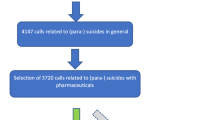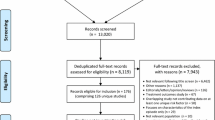Abstract
Background
Self-harm is a major healthcare problem and changes in its prevalence and characteristics can have important implications for clinical services, treatment and prevention.
Methods
We analysed data on all self-harm presentations to the general hospital in Oxford between 1996 and 2010 using the Oxford Monitoring System for Self-harm. We investigated trends in prevalence, methods and repetition of self-harm, and receipt of psychosocial assessment. For patients receiving a psychosocial assessment, we investigated trends in alcohol use and misuse, prior psychiatric treatment and self-harm, problems, and suicidal intent.
Results
Rates of self-harm rose in both genders between 1996 and 2002/2003, after which they declined. There was evidence of a possible cohort effect, whereby higher rates in younger males in earlier years transferred over time to older age groups. Self-cutting, hanging and jumping became more common. Paracetamol was involved in 44.9 % of all self-poisoning episodes. Overdoses of antidepressants (particularly selective serotonin reuptake inhibitors) increased, as did those of mood stabilisers, non-opiate analgesics excluding paracetamol (e.g. non-steroidal anti-inflammatory drugs), and non-ingestible poisons. Alcohol use in relation to self-harm and alcohol-related problems became more common, as did history of prior psychiatric treatment and, especially, of self-harm, and employment problems from 2008. Despite national guidance, the proportion of patients undergoing psychosocial assessment declined.
Conclusions
Major changes in the extent and nature of self-harm occurred over the study period, some suggestive of increased psychopathology and others reflecting prescribing practices and changes in drinking patterns. The findings emphasise the need for psychosocial assessment following self-harm, to identify treatment needs and reduce repetition.





Similar content being viewed by others
References
Kreitman N, Schreiber M (1979) Parasuicide in young Edinburgh women, 1968–1975. Psychol Med 141:37–44
Morgan HG, Pocock H, Pottle S (1975) The urban distribution of non fatal deliberate self harm. Br J Psychiatry 126:319–328
Hawton K, Fagg J, Marsack P, Wells P (1982) Deliberate self-poisoning and self-injury in the Oxford area 1972-1980. Soc Psychiatry 17:175–179
Schmidtke A, Bille Brahe U, De Leo D, Kerkhof A, Bjerke T, Crepet P, Haring C, Hawton K, Lonnqvist J, Michel K, Pommereau X, Querejeta I, Phillipe I, Salander Renberg E, Temesvary B, Wasserman D, Fricke S, Weinacker B, Sampaio Faria JG (1996) Attempted suicide in Europe: rates, trends and sociodemographic characteristics of suicide attempters during the period 1989-1992. Results of the WHO/EURO Multicentre Study on Parasuicide. Acta Psychiatr Scand 93:327–338
Bancroft J, Skrimshire A, Reynolds F, Simkin S, Smith J (1975) Self-poisoning and self-injury in the Oxford area; epidemiological aspects, 1969–73. Br J Soc Prev Med 29:170–177
Hawton K, Fagg J, Simkin S, Bale E, Bond A (1997) Trends in deliberate self-harm in Oxford, 1985–1995. Implications for clinical services and the prevention of suicide. Br J Psychiatry 171:556–560
Hawton K, Harriss L, Hall S, Simkin S, Bale E, Bond A (2003) Deliberate self-harm in Oxford, 1990–2000: a time of change in patient characteristics. Psychol Med 33:987–996
Forster DP, Frost CE (1985) Medicinal self-poisoning and prescription frequency. Acta Psychiatr Scand 71:567–574
Platt S, Hawton K, Kreitman N, Fagg J, Foster J (1988) Recent clinical and epidemiological trends in parasuicide in Edinburgh and Oxford: a tale of two cities. Psychol Med 18:405–418
National Collaborating Centre for Mental Health (2004) Self-harm: the short-term physical and psychological management and secondary prevention of self-harm in primary and secondary care (full guideline) Clinical Guideline 16. National Institute for Clinical Excellence, London
National Institute for Health and Clinical Excellence (2011) Self-harm: longer-term management CG133. National Institute for Health and Clinical Excellence, Manchester
Hawton K, Fagg J (1992) Trends in deliberate self poisoning and self injury in Oxford, 1976–90. BMJ 304:1409–1411
Sellar C, Goldacre MJ, Hawton K (1990) Reliability of routine hospital data on poisoning as measures of deliberate self poisoning in adolescents. J Epidemiol Community Health 44:313–315
Hawton K, Bergen H, Casey D, Simkin S, Palmer B, Cooper J, Kapur N, Horrocks J, House A, Lilley R, Noble R, Owens D (2007) Self-harm in England: a tale of three cities. Multicentre study of self-harm. Soc Psychiatry Psychiatr Epidemiol 42:513–521. doi:10.1007/s00127-007-0199-7
Beck A, Schuyler D, Herman J (1974) Development of suicidal intent scales. In: Beck A, Resnik H, Lettieri DJ (eds) The Prediction of Suicide. Charles Press, Maryland, pp 45–56
Hawton K, Harriss L, Hodder K, Simkin S, Gunnell D (2001) The influence of the economic and social environment on deliberate self-harm and suicide: an ecological and person-based study. Psychol Med 31:827–836
IBM Corp (2011) IBM SPSS Statistics for Windows, Version 20.0. IBM Corp., Armonk
Dean AG, Dean JA, Coulombier D, Brendel KA, Smith DC, Burton AH, Dicker RC, Sullivan K, Fagan RF, Arner TG (1994) EpiInfo Version 6: a word processing database and statistics program for epidemiology on microcomputers. Centers for Disease Control and Prevention, Atlanta
Bergen H, Hawton K, Waters K, Cooper J, Kapur N (2010) Epidemiology and trends in non-fatal self-harm in three centres in England, 2000 to 2007. Br J Psychiatry 197:493–498
Gunnell D, Middleton N, Whitley E, Dorling D, Frankel S (2003) Why are suicide rates rising in young men but falling in the elderly?—a time-series analysis of trends in England and Wales 1950–1998. Soc Sci Med 57:595–611
Hawton K, Rodham K, Evans E, Weatherall R (2002) Deliberate self-harm in adolescents: self report survey in schools in England. BMJ 325:1207–1211
Kidger J, Heron J, Lewis G, Evans J, Gunnell D (2012) Adolescent self-harm and suicidal thoughts in the ALSPAC cohort: a self-report survey in England. BMC Psychiatry 12:69. doi:10.1186/1471-244X-12-69
Gunnell D, Bennewith O, Hawton K, Simkin S, Kapur N (2005) The epidemiology and prevention of suicide by hanging: a systematic review. Int J Epidemiol 34:433–422
Medicines and Healthcare products Regulatory Agency (2006) Venlafaxine (Efexor) Summary of basis for regulatory position. http://www.mhra.gov.uk/Safetyinformation/Safetywarningsalertsandrecalls/Safetywarningsandmessagesformedicines/CON2023846
Stannard C (2012) Opioid prescribing in the UK: can we avert a public health disaster? Br J Pain 6:7–8
Office for National Statistics (2012) Alcohol-related deaths in the UK, 2010. Statistical Bulletin
Bergen H, Hawton K, Waters K, Ness J, Cooper J, Steeg S, Kapur N (2012) Premature death following self-harm: a multicentre cohort study. Lancet 380:1568–1574. doi:10.1016/S0140-6736(12)61141-6
Cooper J, Steeg S, Bennewith O, Lowe M, Gunnell D, House A, Hawton K, Kapur N (2013) Are hospital services for self-harm getting better? An observational study examining management, service provision and temporal trends in England. BMJ Open 3:e003444. doi:10.1136/bmjopen-2013-003444
Hawton K, Bale E, Casey D, Shepherd A, Simkin S, Harriss L (2006) Monitoring deliberate self harm presentations to general hospitals. Crisis 27:157–163
Hawton K, Rodham K, Evans E, Harriss L (2009) Adolescents who self harm: a comparison of those go to general hospital and those who do not. Child Adolesc Mental Health 14:24–30
Orr J (2008) The good, the bad, and the four hour target. BMJ 337:a195. doi:10.1136/bmj.a195
National Institute for Health and Care Excellence (2013) Support for commissioning for self-harm. National Institute for Health and Care Excellence, London
Bergen H, Hawton K, Waters K, Cooper J, Kapur N (2010) Psychosocial assessment and repetition of self-harm: The significance of single and multiple repeat episode analyses. J Affect Disord 127:257–265
Kapur N, Steeg S, Webb R, Haigh M, Bergen H, Hawton K, Ness J, Waters K, Cooper J (2013) Does clinical management improve outcomes following self-harm? Results from the Multicentre Study of Self-harm in England. PLoS One 8:e70434. doi:10.1371/journal.pone.0070434
Acknowledgments
We thank all members of the general hospital self-harm service (Barnes Unit) for assistance with data collection, especially Karen Lascelles, and John Ryall for helping with data entry. We acknowledge financial support from the Department of Health including the Policy Research Programme. KH is a National Institute for Health Research Senior Investigator. The Department of Health had no role in study design, the collection, analysis and interpretation of data, the writing of the manuscript, and the decision to submit the paper for publication. The views and opinions expressed do not necessarily reflect those of the Department of Health or the National Institute for Health Research.
Conflict of interest
The authors have no conflicts of interest.
Author information
Authors and Affiliations
Corresponding author
Rights and permissions
About this article
Cite this article
Hawton, K., Haw, C., Casey, D. et al. Self-harm in Oxford, England: epidemiological and clinical trends, 1996–2010. Soc Psychiatry Psychiatr Epidemiol 50, 695–704 (2015). https://doi.org/10.1007/s00127-014-0990-1
Received:
Accepted:
Published:
Issue Date:
DOI: https://doi.org/10.1007/s00127-014-0990-1




